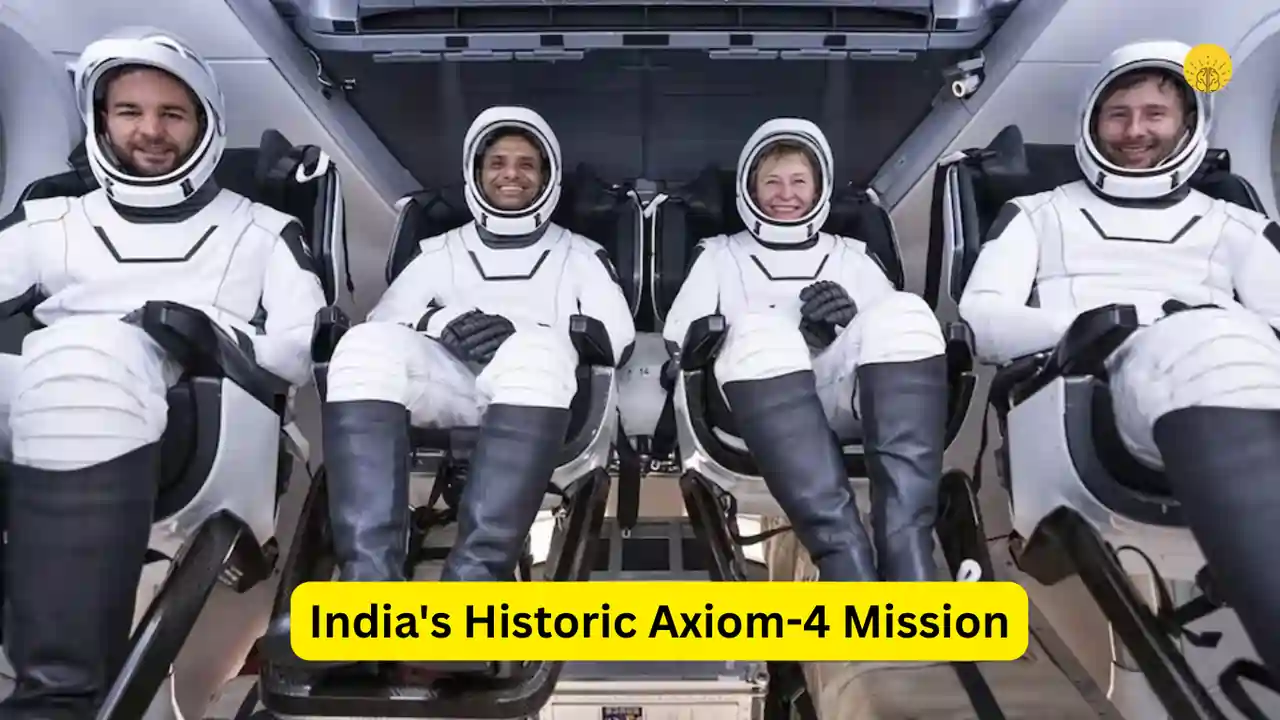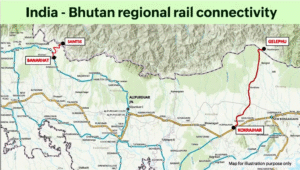
Axiom-4 Mission and the Rise of India’s Human Spaceflight Capabilities
CLAT Current Affairs 2026 | Space Technology Editorial Summary by CLAT Gurukul
Why in News:
Group Captain Shubhanshu Shukla’s return from the International Space Station (ISS), as part of the Axiom-4 mission, marked a watershed moment for India. For the first time since Rakesh Sharma’s 1984 space mission aboard a Soviet craft, an Indian astronaut has completed a complex international mission under a private-public partnership model.
This milestone is not just symbolic—it provides invaluable data, experience, and operational frameworks for India’s upcoming Gaganyaan human spaceflight mission, which will be its first indigenously operated mission. The editorial analyzes why this event matters for India’s ambitions in space and what lessons it offers for both policy makers and future astronauts.
This article is especially relevant for CLAT 2026 aspirants, given the importance of space missions in science and tech awareness, policy reasoning, and even international law. It also offers scope for discussion in legal reasoning regarding international cooperation in space, commercialization, and scientific ethics.
Introduction:
The success of Axiom-4 has placed India on the map of commercial space exploration and international astronautics. It has also set a precedent for how nations like India can leverage collaborative platforms to build indigenous space capabilities. While ISRO has long been a pioneer in satellite and interplanetary missions, human spaceflight demands a different scale of planning, training, and systems integration.
Shubhanshu Shukla’s mission aboard Axiom-4 not only provided him the opportunity to train and operate from the ISS, but it also allowed Indian agencies to study crew management, training models, operational logistics, and emergency protocols. This will now serve as operational input for the Gaganyaan mission.
Point-wise Summary for CLAT Aspirants:
🔹 1. Historical Milestone for India
- Shubhanshu Shukla becomes the first Indian to:
- Return from a complex international space mission
- Participate in a non-governmental international partnership in space
- First such return since Rakesh Sharma’s 1984 Soviet mission
🔹 2. What is Axiom-4?
- Axiom Space is a private American firm focusing on commercial space missions.
- Axiom-4 was a 4-member mission involving astronauts from different countries and backgrounds.
- It allowed nations like India to gain access to human spaceflight training and operations without yet having their own space station.
🔹 3. Lessons for India’s Gaganyaan Mission
- Gaganyaan is India’s upcoming indigenous human spaceflight program under ISRO.
- Axiom-4 gives India insight into:
- Crew selection & training
- Emergency simulation drills
- Logistics of living in microgravity
- Docking operations
- Re-entry and recovery protocols
🔹 4. Spaceflight Training – Key Areas Improved
- Indian authorities observed how commercial astronauts are trained, especially those from non-military backgrounds.
- Valuable lessons in:
- Psychological conditioning
- Physical readiness
- Real-time problem-solving
- These will be vital for selecting future Indian astronauts (termed “vyomnauts”).
🔹 5. Private-Sector Involvement and ISRO’s Vision
- Axiom-4 has shown that private sector collaborations can be highly beneficial.
- India is preparing to build its own space station, succeeding the ISS, with strong private sector participation.
- Companies will now be incentivized to invest in:
- Space infrastructure
- Payload transport
- Recovery and human resource management
🔹 6. Shift from Short-term to Long-term Missions
- Axiom-4 is a model for:
- Long-duration stays
- Complex onboard experiments
- Commercial module management
- Gaganyaan will evolve from short 3-day missions to longer durations, possibly linked to India’s upcoming space station plan.
🔹 7. Importance of Mission Operations and Logistics
- Axiom-4 offered insights into:
- Pre-flight preparation
- Crew rotation schedules
- Hardware testing
- Real-time decision-making
- Helps India develop automated mission command centers, emergency exit plans, and manual override protocols.
🔹 8. Enhancing Technological Infrastructure
- Axiom-4 enabled Indian scientists to observe:
- Life support systems
- Microgravity behavior
- Artificial gravity countermeasures
- These insights are essential for long-term sustainability in orbital and interplanetary missions.
🔹 9. India’s Plans for a National Space Station
- With the ISS scheduled to be decommissioned by 2030, India plans to:
- Develop an Autonomous Orbital Habitat post-2030.
- Use private-public collaboration for both design and operation.
- The learnings from Axiom-4 will serve as a guideline for ISRO’s space station architecture.
🔹 10. Global Implications and Scientific Diplomacy
- India’s participation in such missions enhances:
- Its global standing in space diplomacy
- Its ability to negotiate international agreements in space law
- Demonstrates India’s readiness to lead missions beyond Earth’s orbit, possibly to the Moon or Mars.
Notes: Explanation of Key Terms for CLAT Aspirants
Term | Explanation |
Axiom Space | A US-based private space company planning to build commercial space stations and provide training/missions to global partners. |
Gaganyaan Mission | India’s first human spaceflight program, led by ISRO, with a goal to send a 3-member crew into space. |
Vyomnauts | The proposed term for Indian astronauts (from ‘Vyom’, meaning sky). |
ISS (International Space Station) | A collaborative platform involving the US, Russia, Japan, Europe, and Canada, scheduled to retire by 2030. |
Microgravity | A near weightless condition experienced in orbit, affecting muscle strength and orientation. |
Space Diplomacy | Use of space exploration and cooperation as tools of international relations and policy alignment. |
Relevance for CLAT 2026:
This topic is highly relevant for various CLAT sections:
Section | Relevance |
Current Affairs | India’s participation in Axiom-4, Gaganyaan updates, space diplomacy |
Legal Reasoning | International treaties on space cooperation, private sector liability |
Reading Comprehension | Analyzing editorial tone, argument structure |
General Knowledge | Space science, mission protocols, astronaut training models |
Legal and Policy Dimensions:
Legal Domain | Explanation |
Outer Space Treaty (1967) | Prohibits military use of space, regulates international cooperation. India is a signatory. |
Space Activities Bill (Proposed) | Indian draft legislation to regulate private participation in outer space missions. |
IP & Data Sharing Protocols | In collaborative missions, data ownership and usage rights become a legal issue. |
Liability Convention (1972) | Addresses responsibility for damages caused by space objects. Relevant to joint missions like Axiom-4. |
Takeaways for CLAT Gurukul Students:
- India’s progress in space exploration is a mix of technology, diplomacy, and public-private partnership.
- Axiom-4 gives India live exposure to crew training, emergency planning, and international coordination.
- Gaganyaan is not just a technological leap—it’s a legal and policy challenge in terms of astronaut rights, mission liability, and data regulation.
- Understanding these themes gives students a multi-dimensional grasp of current affairs, science, and international law.
Suggested Practice MCQs:
Q1. What is the primary significance of Axiom-4 for India?
A. First Moon landing by India
B. India’s first indigenous rocket launch
C. Indian astronaut’s participation in an international private-public space mission
D. Launch of India’s own space station
Answer: C
Q2. What is the intended goal of India’s Gaganyaan mission?
A. To build a space telescope
B. To study black holes
C. To send a 3-member human crew to low Earth orbit
D. To establish a base on the Moon
Answer: C
Q3. The term “Vyomnaut” refers to:
A. Private investors in ISRO
B. Satellite engineers
C. Indian space crew members
D. Ground-based support personnel
Answer: C
Conclusion:
The Axiom-4 mission is not just an event—it is a strategic blueprint for India’s space ambitions. It validates the role of international partnerships, private sector support, and scientific collaboration in shaping the future of human spaceflight. As India moves closer to launching its own astronauts, the lessons from Axiom-4 will help convert theory into action, and aspiration into achievement.
For CLAT 2026 aspirants, understanding such events offers insights into scientific, legal, and global cooperation dimensions, preparing you to think like future policymakers and legal professionals.
This Blog is Powered by CLAT Gurukul — India’s Leading Law Entrance Prep Platform
At CLAT Gurukul, we believe in empowering future legal minds with the right blend of knowledge, strategy, and mentorship. This blog is a reflection of our commitment to quality content that not only helps aspirants stay updated but also sharpens their conceptual clarity.
Why CLAT Gurukul?
- Personalized Mentorship by Top Legal Educators
- Comprehensive Study Materials & Legal Updates
- Daily Practice Sets, Mocks & Performance Tracking
- Result-Oriented Strategy for CLAT, AILET, and CUET
Whether you’re reading this article to deepen your understanding or to stay ahead in your exam prep — you’re already one step closer with CLAT Gurukul by your side.
Join thousands of successful aspirants who trusted CLAT Gurukul and cracked India’s top law entrance exams.
Visit https://www.youtube.com/@CLATGurukul/shorts to learn more or speak to our experts now!
Note from CLAT Gurukul
At CLAT Gurukul, we are committed to providing free CLAT study material, including CLAT current affairs, legal reasoning practice sets, general knowledge updates, logical reasoning questions, English comprehension exercises, and more — all curated by top mentors.
Our blog section is regularly updated with high-quality CLAT content tailored to match the evolving pattern of the CLAT UG exam. Whether you’re looking for CLAT 2026 current affairs, CLAT legal reasoning passages, or mock practice sets, we have you covered.
We believe in open-access learning and will continue to publish free CLAT preparation resources to help serious aspirants succeed.
Explore more free content under categories like:
Best online coaching for CLAT, CLAT current affairs, CLAT GK updates, CLAT legal updates, CLAT logical reasoning, and CLAT English preparation.
For structured learning, daily mocks, and expert mentorship, visit https://www.youtube.com/@CLATGurukul/shorts — the Best CLAT Coaching in Patna and India’s most trusted platform for CLAT online coaching.




